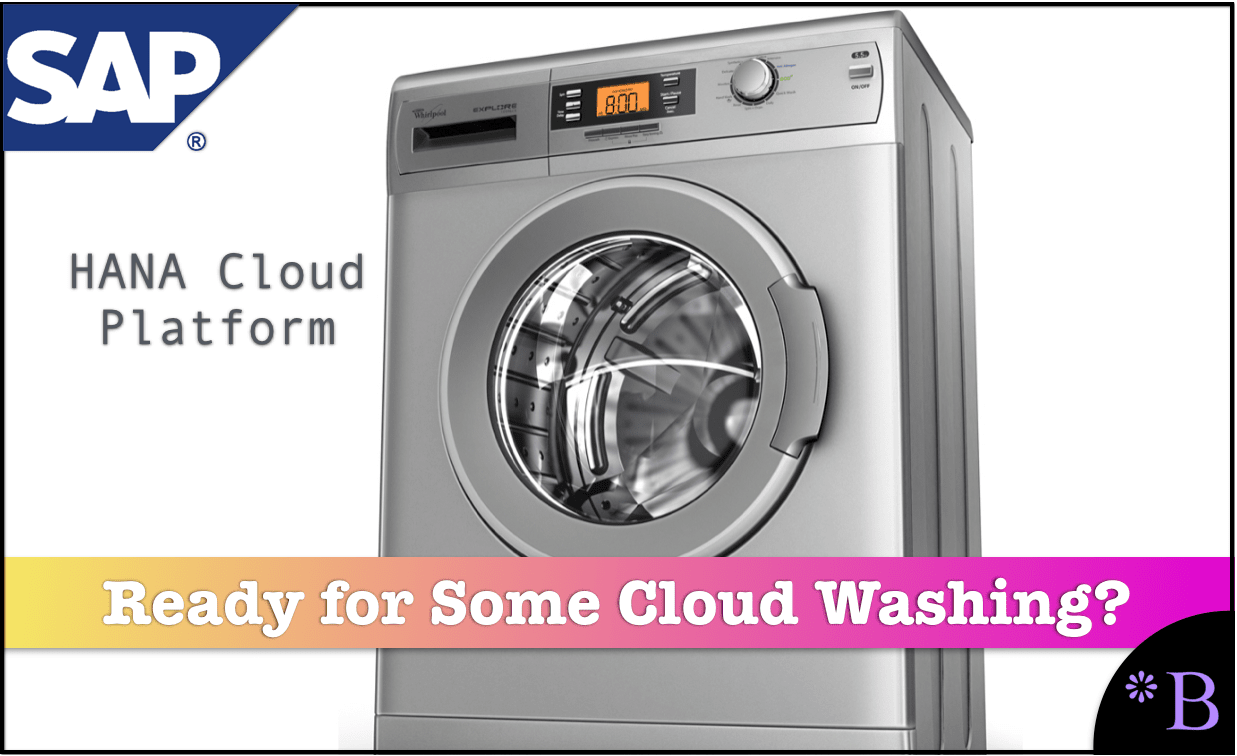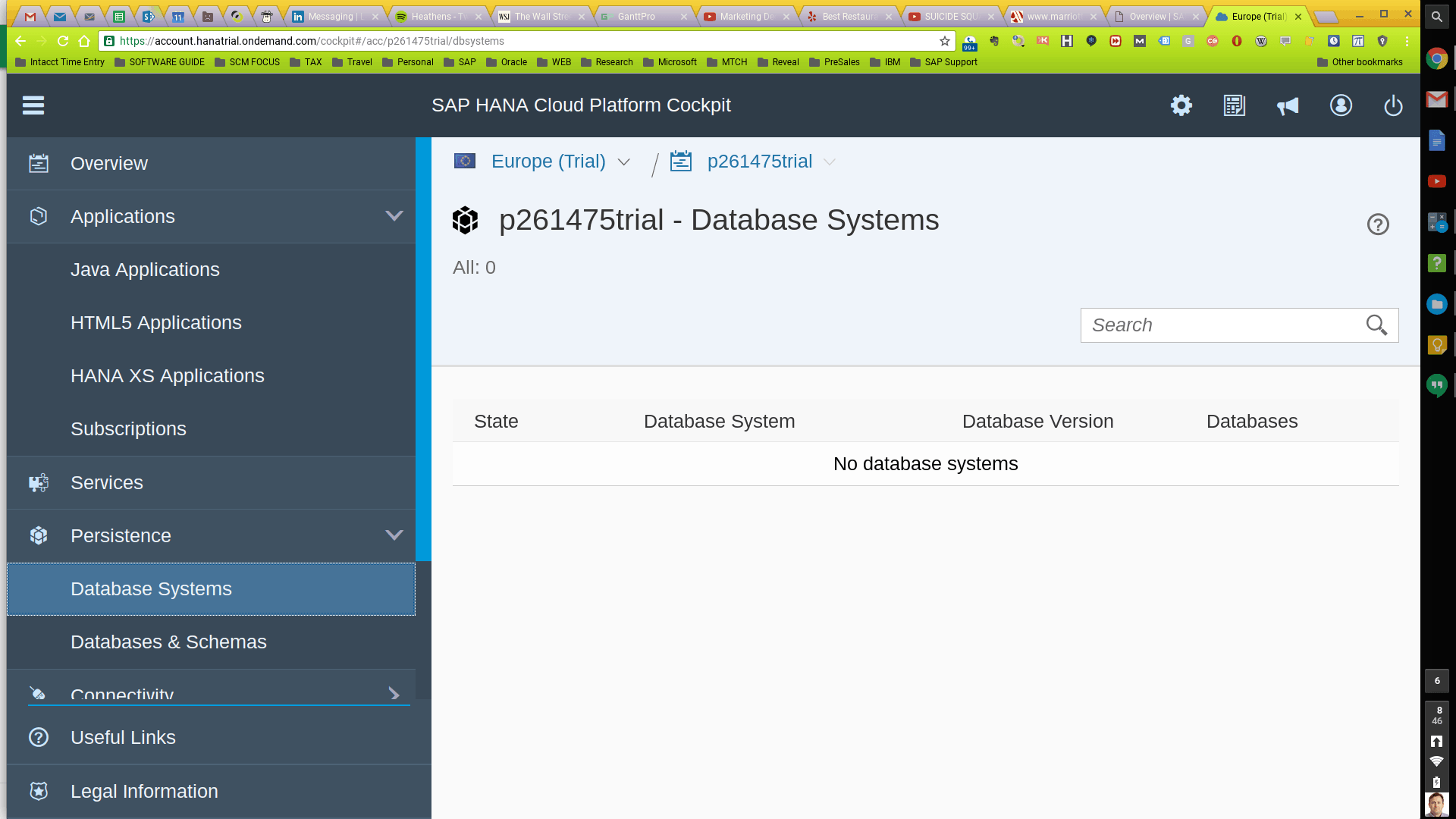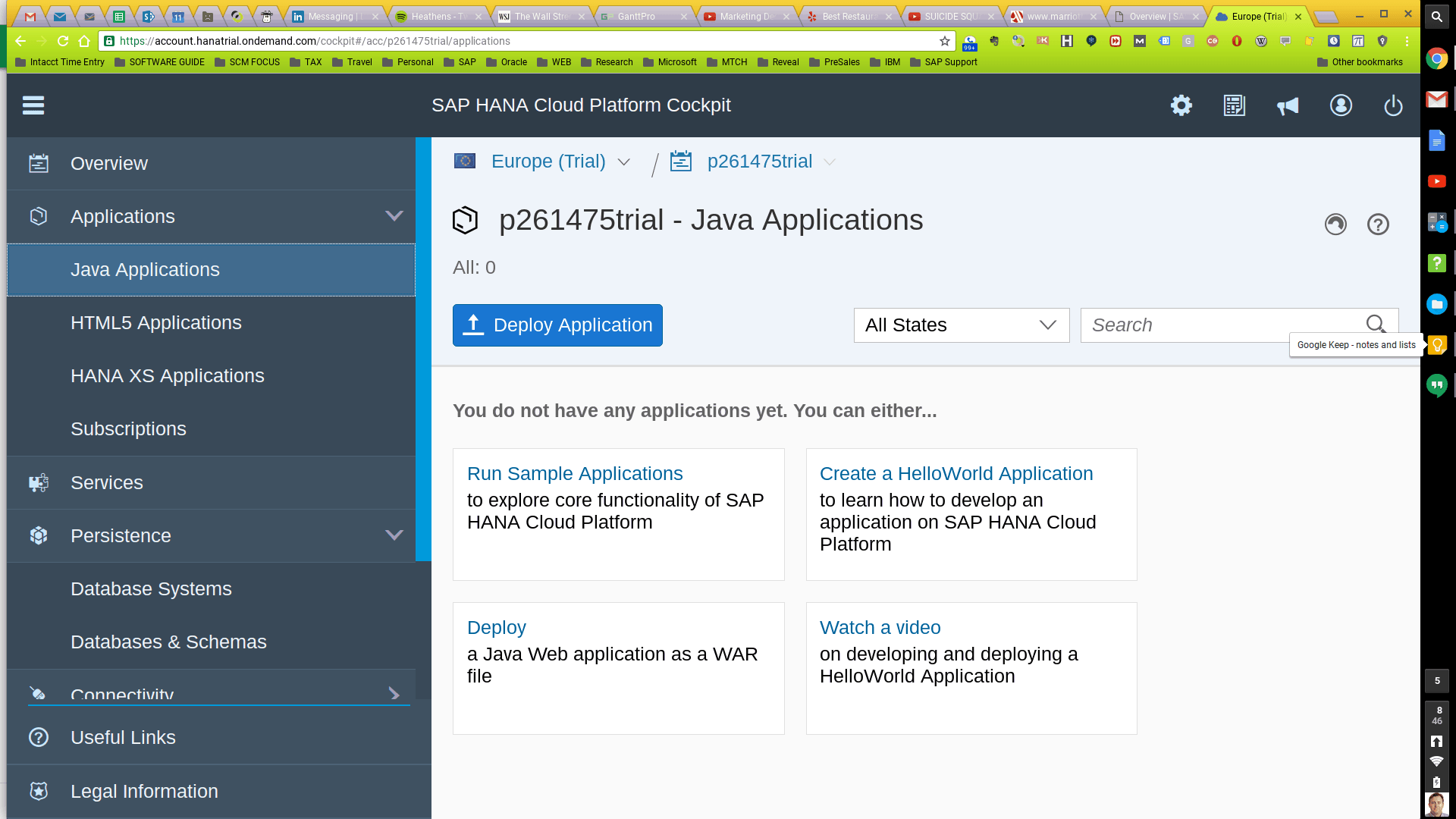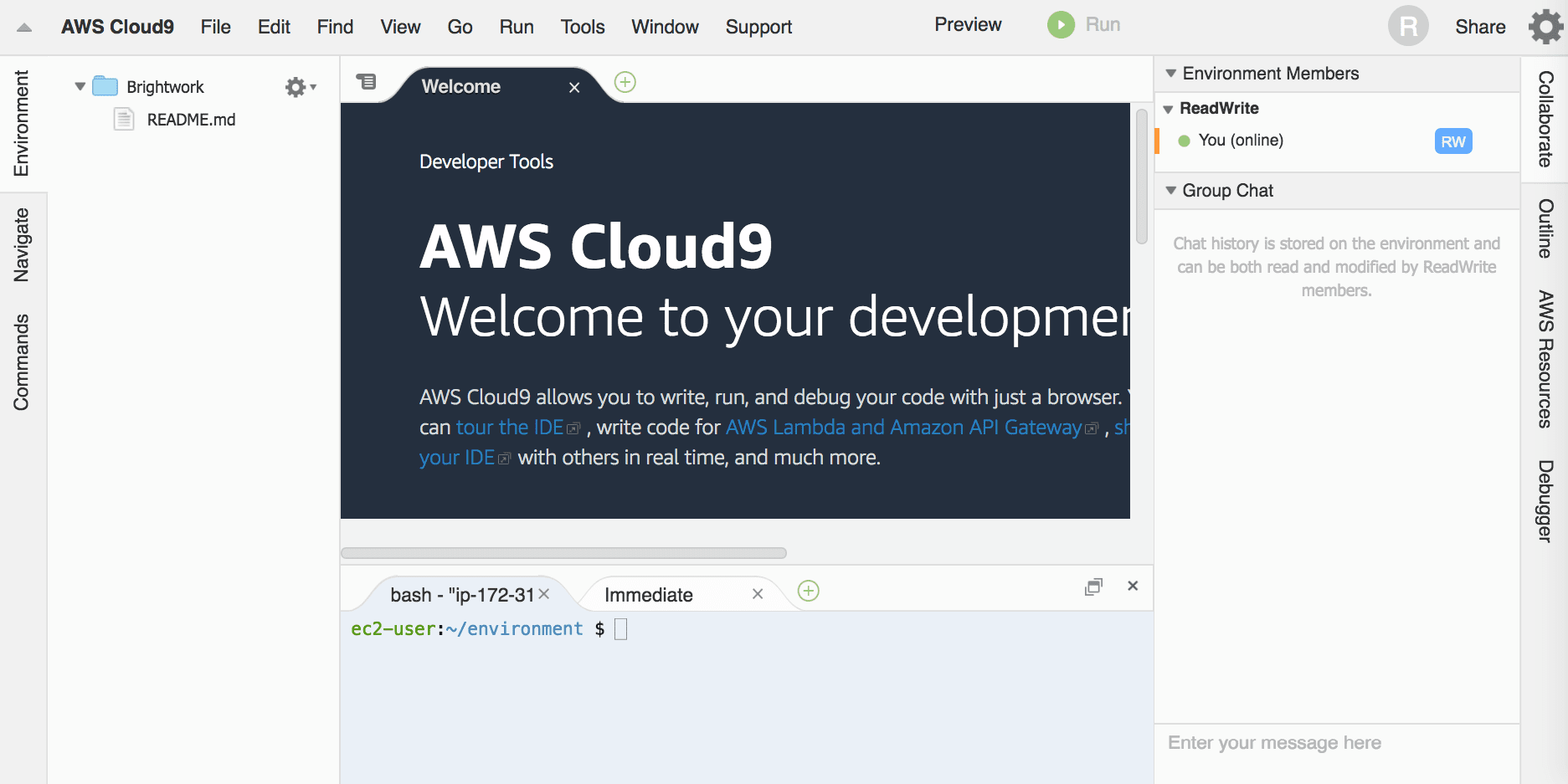Is the SAP HANA Cloud Platform Designed for Cloud Washing?
Executive Summary
- SAP introduced the HANA Cloud Platform and immediately began using it for Cloud washing.
- This makes it appear that everything related to the HCP is also related to the cloud.

Video Introduction: Is the SAP HANA Cloud Platform Designed for Cloud Washing?
Text Introduction (Skip if You Watched the Video)
SAP’s marketing department has been using the SAP HANA Cloud Platform to have the word “Cloud” in the name of HANA, even though it has nothing to do with HANA and even though most HANA instances are on premises and SAP does not provide hosting for the vast majority of applications that it states are part of its cloud. SAP has been using this development environment to cloud washing its other applications. This is because SAP is desperate to position its products as cloud. You will learn how SAP manipulates terminology to deceive its customers.
Our References for This Article
If you want to see our references for this article and other related Brightwork articles, see this link.
Notice of Lack of Financial Bias: We have no financial ties to SAP or any other entity mentioned in this article.
What is Cloud Washing?
The industry term presents one’s revenues as more cloud-based than they are called “cloud washing.”
Vinnie Mirchandani, the author of SAP Nation, has explained that SAP presents itself as a cloud-based software vendor to Wall Street. But then eagerly sells on-premise software.
At this point, if a software vendor can, they want to present themselves and their applications as more cloud-based than they are. One of the ways that SAP has historically been an on-premises vendor is the following:
- Acquiring cloud software vendors
- Saying that applications that are primarily purchased as on-premises are available in the cloud.
- Adding cloud terms to the names of products.
What is the SAP HANA Cloud Platform?
Some people incorrectly state that HANA is both a database/development environment and application. This is not correct. One of the reasons for this confusion is because HANA was added to the name of SAP’s connective development environment. This was for marketing reasons. But it has caused people to become confused as to what part does what.
This is not correct.
One of the reasons for this confusion is because HANA was added to the name of SAP’s connective development environment. This was for marketing reasons. But it has caused people to become confused as to what part does what.
One of the reasons for this confusion is because HANA was added to the name of SAP’s connective development environment. This was for marketing reasons. But it has caused people to become confused as to what part does what.
- HANA is a database
- HCP is a development environment
- Neither is an application
- Neither is it a platform
The SAP HANA Cloud Platform is a development environment and not a platform. A development environment allows you to code to create custom programs. The development environment needs to connect to things like databases. There are many development environments out there, and this is not something that SAP has historically offered.

This is a view of the SAP HANA Cloud Platform. As you can see, the SAP HANA Cloud Platform items that can be connected to are on the right. This includes databases.

This view shows the applications that the SAP HANA Cloud Platform can connect to. This is what development environments do.

This is Cloud9. It is another development environment that is in the cloud.
Just because a development environment is in the cloud does not mean that everything the development environment connects to is based in the cloud. This is a misperception that SAP is trying to give its audience. Here are some examples of why this is misleading:
- Almost all HANA instances are on-premises.
- In almost all BW instances, the most common usage of HANA is on-premises.
- S/4 is right now, not a finished product (covered in detail in this article Why the S/4 Suite is Not Yet Released). However, most S/4 implementations are also on-premises.
What SAP would like people to think, customers and Wall Street alike, is that because customers use a cloud-based development environment to connect to on-premises installations (which HCP, of course, allows), that the overall installation is the cloud? If SAP successfully does this, it could potentially cloud wash many installations that have almost nothing to do with the cloud.
How Does SAP Use HANA Cloud Platform to Perform Cloud Washing?
SAP consistently uses the idea that companies can use the HANA Cloud Platform to do all manner of amazing things. The HCP required little work on the part of SAP. They created a development environment that can connect to other items. Talk about laziness.
And from this tiny amount of effort, McDermott and I will use it as a discussion point to talk about how cloud SAP is becoming. And the difference between how much HCP is discussed versus how much it is used is enormous.
- We still have no idea that the HCP will even become popular, but this will not stop SAP marketing from using it.
- Developers may continue to develop in whatever environment they presently use.
- Should SAP dictate the development environment that developers use? Especially when it adds nothing over what developers already use?
SAP misuses the term cloud in everything from its videos to its press releases. Much of this audience does not know what an actual cloud implementation is. So it’s easy for SAP to misleading them, and this is SAP’s primary goal.
SAP has this video about the HANA Cloud Platform.
How Does SAP Use the SAP HANA Cloud Platform to Perform Cloud Washing?
SAP consistently uses the idea that companies can use the SAP HANA Cloud Platform to do all manner of amazing things. The HCP required little work on the part of SAP. They created a development environment that can connect to other items. Talk about laziness. And from this tiny amount of effort, McDermott and I will use it as a discussion point to talk about how cloud SAP is becoming. And the difference between how much the SAP HANA Cloud Platform is discussed versus how much it is used is enormous. We still have no idea if the SAP HANA Cloud Platform will even become famous. SAP may offer it for free. Developers may continue to develop in whatever environment they presently use.
Should SAP be dictating the development environment that developers use? Especially when it adds nothing over what developers already use?
SAP misuses the term cloud in everything from its videos to its press releases. Much of this audience does not know what an actual cloud implementation is. So it’s easy for SAP to misleading them, and this is SAP’s primary goal.
SAP has this video about the SAP HANA Cloud Platform.
This video is entirely misleading. SAP makes it sound as if the SAP HANA Cloud Platform can allow companies to magically connect to either SAP applications or nonSAP applications with the SAP HANA Cloud Platform. I have news for people. SAP is not giving companies anything they don’t already have.
Second, all of this is work. It is custom programming. SAP simplifies things to a stupefying degree in these videos, which will lead such projects to be considerably underestimated. They are showing electrical plugs going to applications and databases.
The script that goes with this image in SAP’s video is as follows:
“The SAP HANA Cloud Platform, the in-memory Platform-as-a-Service offering from SAP, enables customers and developers to build, extend, and run applications on SAP HANA in the cloud.”
This makes the SAP HANA Cloud Platform sound like a magic box. However, all SAP is offering is a development environment accessed from the cloud. This completely overstates what SAP customers that use SAP HANA Cloud Platform’s capabilities. We have gone through this so many times.
We have gone through this so many times.
- There is no magic box for application integration.
- Remote function calls have not powered up applications integration, or by XML or SOA (remember software oriented architecture) or any trendy things.
Where Did the Previous Savior of Integration, XML Go?
I can recall explaining to executives back in the late 1990s that what the salespeople told them that XML would “take care of the integration” was untrue. XML is a document format, and after everyone got all bubbly about XML, you now barely hear about it. However, the salespeople I worked with told companies that XML would perform the complete application integration. I had to break the bad news to them that XML is only a document format.
Here again, talking about application integration is something easy that is powered by some new trendy item. Every year since 2009, the number of APIs that support XML has declined.
Application integration operates through removing data from databases to where a flat file is created. This flat file is then imported back into the recipient database. Electrical plugs and magic don’t apply.
SAP removed this video from YouTube.
In this video, the presenter makes misleading statements throughout the video, and it is directed towards people who know little about computers or software. Silly words like “Business Process APIs” and “Digital Applications” are used. It also repeats the incorrect assertion that Fiori is merely ready to use — when in fact, there is almost no one using Fiori presently, and it just a series of apps that every client must pick and choose.
This video is a continuation of SAP’s marketing material that presents a fantasy land to customers, prospective customers, and Wall Street. I have been working on SAP projects since 1997, and this video has nothing to do with how things work on projects. One might as well watch Saturday morning cartoons.
The entire point of these videos is to make everything seem easier to accomplish than it is.
Who Provides the Hosting Again?
SAP states the following for everything connected to the SAP HANA Cloud Platform.
All hosting services are provided by SAP
Because SAP is hosting the free SAP HANA Cloud Platform, SAP will host every resource, every database, and every SAP application that the SAP HANA Cloud Platform interacts with? I don’t think so. Third-party partners or AWS mostly carry out the hosting that is performed for SAP products. Most customers will not choose to host with SAP because SAP’s hosting is not competitive. SAP also has a small hosting capacity. If SAP truly intends to restrict the SAP HANA Cloud Platform to only SAP hosted applications and databases, then the adoption of the SAP HANA Cloud Platform will be far lower than it ordinarily would have been. It also brings up the question of why the HCP is not open? That is why can’t the SAP HANA Cloud Platform, like all other development environments that I am familiar with, access any application or database wherever it is hosted.
Conclusion
- SAP’s naming of the SAP HANA Cloud Platform and their discussion around SAP HANA Cloud Platform is deceptive.
- Almost no one uses the SAP HANA Cloud Platform, so SAP can say whatever they want to about it.
- The SAP HANA Cloud Platform will be used in SAP’s marketing offensives to mislead companies. Both regarding how much SAP installations are cloud-based and how much HANA is deployed.
- If the SAP HANA Cloud Platform never rises above even a tiny fraction of users, this will not stop SAP from telling customers and Wall Street that it is revolutionizing projects. And even better, its growth cannot be tracked because it is free and will not have any revenues to report. I see the SAP HANA Cloud Platform being saddled up by SAP marketing to be ridden for a long time.
In the next article, I will cover why the term HANA was used in the name of the SAP HANA Cloud Platform.